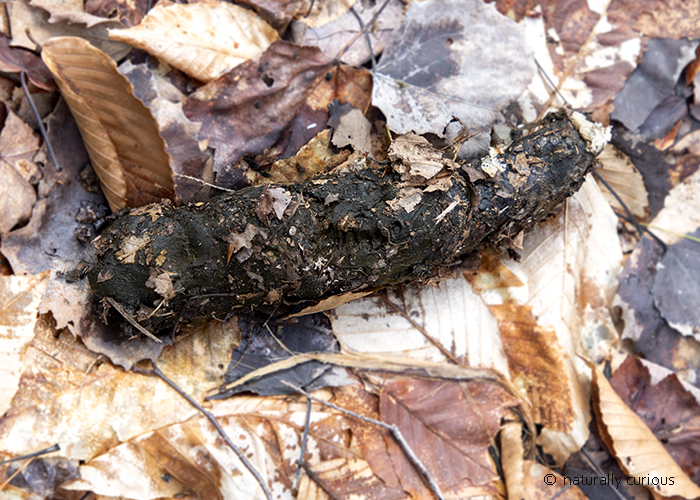Black Bears Waking Up & Ejecting Fecal Plugs

Black Bears spend their entire hibernation with what is referred to as a “fecal plug” in the last foot or so of their intestines. Scientists used to theorize that bears ate lots of roughage and indigestible plant material in order to form this plug that essentially prevents them from evacuating all winter. This theory has been proven wrong, as investigation has shown that the fecal plug consists mainly of intestinal secretions and cells that have sloughed off the inside of the digestive tract. After stopping eating in late fall, bears do produce a small amount of feces, which are in the plug along with hair and leafy bedding, both accumulated from increased grooming (licking of fur and then swallowing) that takes place before entering hibernation. During winter bears shed the calloused soles, or footpads, of their feet and it’s not uncommon to find pieces of them in a plug, as well.
Most fecal plugs measure 1 ½” to 2 ½” in diameter and 7”-15″ long. Fluids have been absorbed from the plug by the intestinal walls, leaving it relatively dry and hard. Its light scent is reminiscent of fermentation. Should you be fortunate enough to find a plug, it’s likely you’re quite close to its owner’s overwintering den, as bears eject their plug soon after emerging from hibernation. (Many thanks to Metta McGarvey and Stephen Brown for sharing their 9″ x 2″ fecal plug with me.)
Naturally Curious is supported by donations. If you choose to contribute, you may go to http://www.naturallycuriouswithmaryholland.wordpress.com and click on the yellow “donate” button.
Black Bears Emerging From Dens & Ejecting Fecal Plugs
 This may look like Black Bear scat to many viewers and it is close to being just that, but technically it is a fecal plug. A plug differs from scat in several ways. Rather than passing through and out of the digestive system, it remains in the lower 7-15” of a bear’s intestine for four or five months, while the bear hibernates. Unlike feces, which consist mostly of waste from digested food, a fecal plug, due to the length of time it spends in the intestine, contains a considerable amount of intestinal secretions and cells that have sloughed off the inside of the digestive tract.
This may look like Black Bear scat to many viewers and it is close to being just that, but technically it is a fecal plug. A plug differs from scat in several ways. Rather than passing through and out of the digestive system, it remains in the lower 7-15” of a bear’s intestine for four or five months, while the bear hibernates. Unlike feces, which consist mostly of waste from digested food, a fecal plug, due to the length of time it spends in the intestine, contains a considerable amount of intestinal secretions and cells that have sloughed off the inside of the digestive tract.
Usually you find hair and bedding as well as recently-eaten indigestible food incorporated into a plug. Prior to hibernation, Black Bears engage in grooming — licking and swallowing their fur and the leaves, etc. that are caught in it. These indigestible materials end up in the plug. During winter bears shed the calloused soles, or footpads, of their feet and it’s not uncommon to find pieces of them in a plug, as well.
Most plugs measure 1 ½” to 2 ½” in diameter and 7-15″ long. Fluids have been absorbed from the plug by the intestinal walls, leaving it quite dry and hard, and it has very little scent. If you happen to know where a bear has denned, the surroundings are a prime location for finding a plug, as the bear ejects it soon after emerging from its den in April. (Thanks to Andy Rowles and Erin Donahue for photo op.)
Naturally Curious is supported by donations. If you choose to contribute, you may go to http://www.naturallycuriouswithmaryholland.wordpress.com and click on the yellow “donate” button.


















What Other Naturally Curious People Are Saying